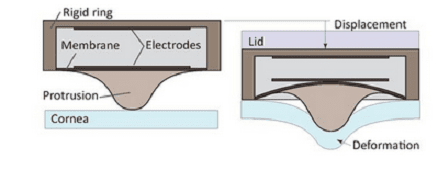EPFL Develops Glaucoma Detecting Single Use Contact Lenses
The researchers from École polytechnique fédérale de Lausanne (EPFL) and Haute Ecole Arc Institutes have participated in the development of a single-use contact lenses for the early detection of glaucoma. Globally, glaucoma is the second leading cause of blindness after cataracts. Glaucoma is an insidious disease leading to increased pressure, called intraocular pressure, on the eye's optic nerve that transmits images to the brain. The painless and invisible damage gets worse over time. But, this condition is detected too late by the doctors when considerable amount of damage is already done to the optic nerve.

The traditional technique called Goldmann Applanation Tonometry is used to detect glaucoma by most of the ophthalmologists where the flat tip kind of cone is applied against the cornea in order to measure the intraocular pressure. It is not easy to detect abnormal rates of pressure i.e peak pressures that are prevalent during night or in early morning time. And, therefore, the measurements are done on an ad hoc basis while consulting as these time durations are outside normal consultation hours.
In order to bridge this gap, the startup, Tissot Medical Research (TMR), has commissioned the researchers from EPFL and Haute Ecole Arc to develop single-use contact lens which is composed of silicone and can measure the pressure continuously for 24 hours. This novel lens can track glaucoma day and night and also at each blink of the eye. The measurements are performed by using the same principle as that of traditional method.

With each blink of the eye, a protuberance, present in the lens, is pressed against cornea. Inside the lens, there is a rigid ring which contains a capacitive sensor. The sensor is formed by electrodes. The rate of intraocular pressure is indicated by the distance between the electrodes as these electrodes come closer when the eyelid closes. The information captured by the lens is regularly collected by the small antennas that are connected to the patient's pair of glasses which is further connected to the portable, wallet size box. This enables the patients to carry on their usual work when the diagnosis is going on. After 24 hours, the ophthalmologists can analyze the results on a computer.
The researchers also want to measure the cornea’s biomechanical properties by using this smart lens. The clinical trials are taking place at Ophthalmic Hospital of CHUV. The lens will be commercially available by the end of 2015.
Source: <a href="https://actu.epfl.ch/news/an-innovative-contact-lens-for-glaucoma-2/" target="_blank" rel="nofollow noopener noreferrer">An innovative Contact Lens for Glaucoma - EPFL</a>
The traditional technique called Goldmann Applanation Tonometry is used to detect glaucoma by most of the ophthalmologists where the flat tip kind of cone is applied against the cornea in order to measure the intraocular pressure. It is not easy to detect abnormal rates of pressure i.e peak pressures that are prevalent during night or in early morning time. And, therefore, the measurements are done on an ad hoc basis while consulting as these time durations are outside normal consultation hours.
In order to bridge this gap, the startup, Tissot Medical Research (TMR), has commissioned the researchers from EPFL and Haute Ecole Arc to develop single-use contact lens which is composed of silicone and can measure the pressure continuously for 24 hours. This novel lens can track glaucoma day and night and also at each blink of the eye. The measurements are performed by using the same principle as that of traditional method.
With each blink of the eye, a protuberance, present in the lens, is pressed against cornea. Inside the lens, there is a rigid ring which contains a capacitive sensor. The sensor is formed by electrodes. The rate of intraocular pressure is indicated by the distance between the electrodes as these electrodes come closer when the eyelid closes. The information captured by the lens is regularly collected by the small antennas that are connected to the patient's pair of glasses which is further connected to the portable, wallet size box. This enables the patients to carry on their usual work when the diagnosis is going on. After 24 hours, the ophthalmologists can analyze the results on a computer.
The researchers also want to measure the cornea’s biomechanical properties by using this smart lens. The clinical trials are taking place at Ophthalmic Hospital of CHUV. The lens will be commercially available by the end of 2015.
Source: <a href="https://actu.epfl.ch/news/an-innovative-contact-lens-for-glaucoma-2/" target="_blank" rel="nofollow noopener noreferrer">An innovative Contact Lens for Glaucoma - EPFL</a>
0
